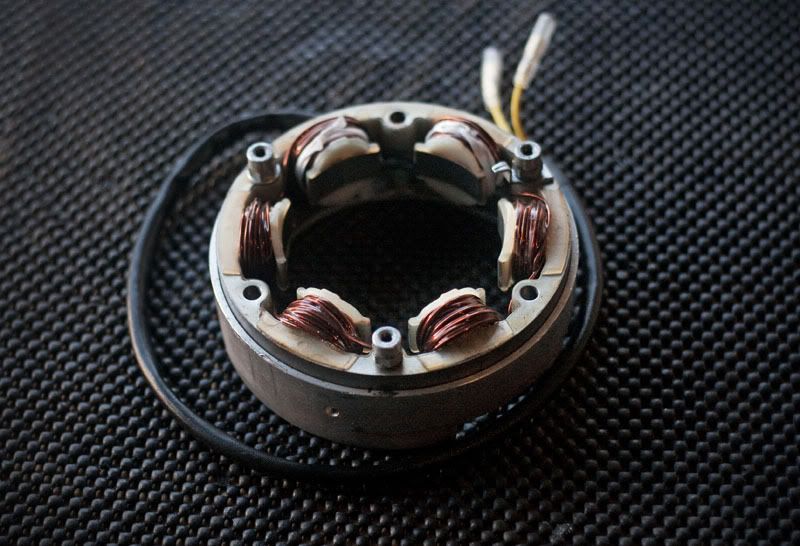honda305.com Forum
Vintage Honda Owners, Restorers, Riders and Admirers
Latest Registry Entry
1965 Honda CP77 — Ulsan Metro City, Rep. Korea
Restored with original parts — Owner: J. Doe
Rick's Motorsports Aftermarket Stator - 2 Wires
It took some time to break the old stator free from the mounting piece, which was filthy. Looked as if it has never been cleaned in it's life. Lots of hardened, caked on grease from the chain that had found it's way in over the years. As seen the in the photo it's held in place by three bolts. The TDC indicator had to be cut and chiseled off the old stator. I then threaded it through one of the bolts that holds the stator onto the mounting piece; a little JB Weld to help hold it there. The new stator is much more shallow so I'll need to get some shorter bolts to hold it in place, or cut down the existing ones and recut the treads. All in all it was relatively simple.
Steve, you say you don't think it needs either the pink or yellow wire? There's two wires coming off, that would only leave one "brown" wire still in use, instead of the two that are instructed to run to the rectifier?


Steve, you say you don't think it needs either the pink or yellow wire? There's two wires coming off, that would only leave one "brown" wire still in use, instead of the two that are instructed to run to the rectifier?


Current restoration: 1962 CB77
http://www.flickr.com/photos/1962_cb77_restore/
http://www.flickr.com/photos/1962_cb77_restore/
Scott,
I would be very interested in knowing how a 25% increase in generator power has been achieved with your new stator. I visited the link to Rick's in one of your prior posts, but there wasn't much information for me to go on. Did they provide you with more informative literature than shows on the website?
Wilf
I would be very interested in knowing how a 25% increase in generator power has been achieved with your new stator. I visited the link to Rick's in one of your prior posts, but there wasn't much information for me to go on. Did they provide you with more informative literature than shows on the website?
Wilf
I plan on running a brighter H4 headlight during the day and night for safety's sake. If it runs that and charges well, then it's confirmed! Which is what is claimed on the site.
There wasn't any more information than what's online. Very, very, rudimentary instructions are included. "Remove old stator, install new stator, plug in yellow both wires", etc.
I had to shorten the wires quite a bit, almost half as short and put male bullets on instead of the female that are included.
There wasn't any more information than what's online. Very, very, rudimentary instructions are included. "Remove old stator, install new stator, plug in yellow both wires", etc.
I had to shorten the wires quite a bit, almost half as short and put male bullets on instead of the female that are included.
Current restoration: 1962 CB77
http://www.flickr.com/photos/1962_cb77_restore/
http://www.flickr.com/photos/1962_cb77_restore/
Scott,
The reason I ask is that the power generated is a product of the magnetic flux (how strong the magnets are, and their positioning relative to the coils) and how fast the coils pass through the magnetic fields.
Your rotor is the same, so there has been no change in the magnet strength. Rotor rpm's will be the same, so there is no change in coil speed. That leaves the coils in the new stator to be producing the 25% increase in power. That's quite a bit to ask of them.
I know that to use a modern regulator, the stator output voltage has to be higher than before, and that could easily be accomplished with more turns in each coil, but that generally comes by sacrificing wire size which leads to power loss through heat, so it's a trade-off. You get more volts but fewer amps, or vice versa.
I guess I'm just curious as to whether Honda's original stator design was not at peak efficiency in the first place. Maybe we could all just add a few more turns to each coil, poke in a modern regulator and charge happily ever after?
Have you been able to figure out how the new stator connects to the rectifier and regulator? That part puzzles me still.
Wilf
The reason I ask is that the power generated is a product of the magnetic flux (how strong the magnets are, and their positioning relative to the coils) and how fast the coils pass through the magnetic fields.
Your rotor is the same, so there has been no change in the magnet strength. Rotor rpm's will be the same, so there is no change in coil speed. That leaves the coils in the new stator to be producing the 25% increase in power. That's quite a bit to ask of them.
I know that to use a modern regulator, the stator output voltage has to be higher than before, and that could easily be accomplished with more turns in each coil, but that generally comes by sacrificing wire size which leads to power loss through heat, so it's a trade-off. You get more volts but fewer amps, or vice versa.
I guess I'm just curious as to whether Honda's original stator design was not at peak efficiency in the first place. Maybe we could all just add a few more turns to each coil, poke in a modern regulator and charge happily ever after?
Have you been able to figure out how the new stator connects to the rectifier and regulator? That part puzzles me still.
Wilf



